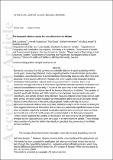Files in this item
The temporal relations across burnout dimensions in athletes
Item metadata
| dc.contributor.author | Lundkvist, E. | |
| dc.contributor.author | Gustafsson, H. | |
| dc.contributor.author | Davis, P. A. | |
| dc.contributor.author | Holmström, S. | |
| dc.contributor.author | Lemyre, N. | |
| dc.contributor.author | Ivarsson, A. | |
| dc.date.accessioned | 2018-11-19T00:55:34Z | |
| dc.date.available | 2018-11-19T00:55:34Z | |
| dc.date.issued | 2018-03 | |
| dc.identifier | 251552338 | |
| dc.identifier | b86ba762-219c-4511-9278-35eeb10b0a37 | |
| dc.identifier | 85034241834 | |
| dc.identifier | 000426529300049 | |
| dc.identifier.citation | Lundkvist , E , Gustafsson , H , Davis , P A , Holmström , S , Lemyre , N & Ivarsson , A 2018 , ' The temporal relations across burnout dimensions in athletes ' , Scandinavian Journal of Medicine & Science in Sports , vol. 28 , no. 3 , pp. 1215-1226 . https://doi.org/10.1111/sms.13000 | en |
| dc.identifier.issn | 1600-0838 | |
| dc.identifier.other | Bibtex: urn:9cab13be2c75232c271ba3d57655454d | |
| dc.identifier.uri | https://hdl.handle.net/10023/16495 | |
| dc.description.abstract | Burnout is a construct that has garnered considerable attention in sport psychology within recent years. Several hypothesized models regarding how the three dimensions (exhaustion, devaluation, and reduced sense of accomplishment) temporally relate to each other have been advanced. One proposal outlined by Maslach and Leiter suggests that exhaustion predicts devaluation which predicts reduced sense of accomplishment. However, there is no consensus among researchers as it has been argued that exhaustion predicts devaluation and reduced accomplishment separately. The aim of this study was to test multiple alternative hypotheses regarding the relationships of the burnout dimensions in athletes. Two samples of Swedish youth elite athletes with differing time spans between measurements were used. Specifically, one sample involved time-intensive measures collected every week over an eight-week period, and the other sample included four measurement points across an 18-month period. Results showed that none of the previously proposed models outlining the temporal relations of burnout dimensions were supported. Statistical analysis of the models including the cross-lagged predictions of dimensions did not have any statistically significant impact except when exhaustion negatively predicted devaluation between time 1 (month 0) and time 2 (month 6) in the 18-month sample; this relation faded in the following time points. Further, issues regarding the stability of devaluation and reduced sense of accomplishment emerged as their autocorrelation were very weak in the time-intensive sample. These findings raise a number of points for further theoretical and practical discussions about the athlete burnout construct. | |
| dc.format.extent | 12 | |
| dc.format.extent | 570810 | |
| dc.language.iso | eng | |
| dc.relation.ispartof | Scandinavian Journal of Medicine & Science in Sports | en |
| dc.subject | Athlete burnout | en |
| dc.subject | Athlete stress | en |
| dc.subject | Burnout | en |
| dc.subject | Causality | en |
| dc.subject | Multivariate latent curve model with structured residuals | en |
| dc.subject | RC1200 Sports Medicine | en |
| dc.subject | BF Psychology | en |
| dc.subject | NDAS | en |
| dc.subject.lcc | RC1200 | en |
| dc.subject.lcc | BF | en |
| dc.title | The temporal relations across burnout dimensions in athletes | en |
| dc.type | Journal article | en |
| dc.contributor.institution | University of St Andrews. School of Geography & Sustainable Development | en |
| dc.identifier.doi | https://doi.org/10.1111/sms.13000 | |
| dc.description.status | Peer reviewed | en |
| dc.date.embargoedUntil | 2018-11-19 |
This item appears in the following Collection(s)
Items in the St Andrews Research Repository are protected by copyright, with all rights reserved, unless otherwise indicated.

